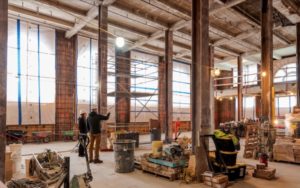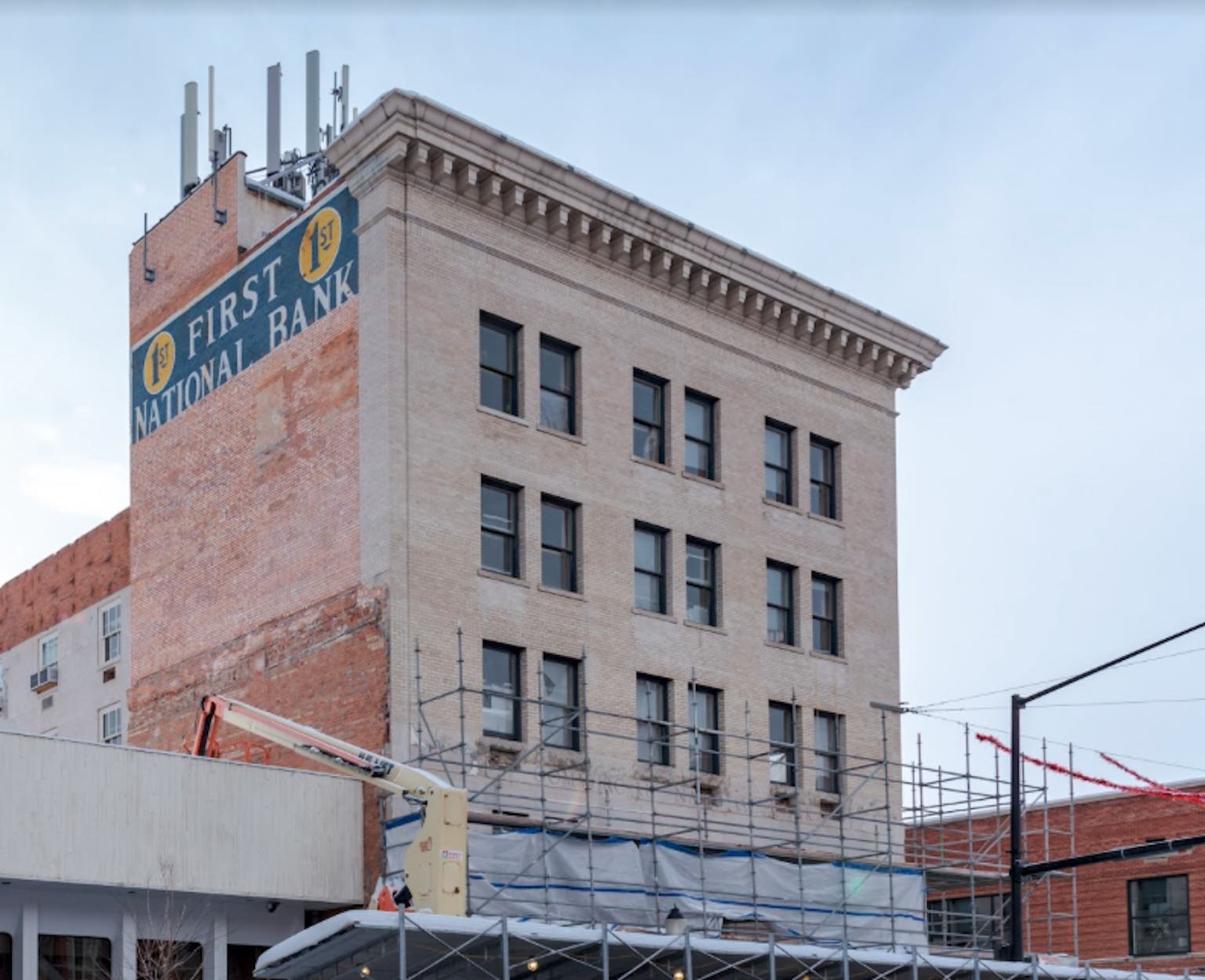By Mira Brody
Inside the first floor of the U.S. Bank building in downtown Bozeman, Montana, you can just hear the muffled sounds of lunchtime traffic on Main Street, a gentle hum that grows as the city does. Inside, however, time has momentarily stopped.
Small piles of brick and rebar litter the floor. A thick layer of dust obstructs an intricate black and white terrazzo pattern beneath our feet. Strong steel beams and Montana-quarried limestone walls reach up four more stories, stoic since the building was initially constructed over a century ago. Despite its state, the craft put into its original iteration echoes throughout the space. We are in the epicenter of Randy Scully’s latest project.
In this case, progress is moving backwards, removing the white and black stucco and tile, and dark sunscreen façade brought on by a major renovation in 1972 that obstructed much of Fred Fielding Willson’s original design.
Scully, owner of Scully Partner Group, SPG, has been taking on development and revitalization projects in the area for a decade, following a lifelong passion for preserving the spirit of the West. As he walks around the empty building, which he’s named The National, he points out his vision for the next life of the 100-year-old building.
“These guys were true craftsmen,” said Scully, eyes running over the hot-riveted steel beams that stretch up past the mezzanine and through the ceiling to the third floor. “I mean, the craftsmanship in this building is amazing; the marble for the base, terrazzo for the floors, white oak for the trim. And then the steel, as they build up, gets smaller and smaller until it pokes through the roof as if they were anticipating another addition.”
Although adding stories is not in the plan, seismic and safety-related upgrades and enhanced energy efficiency are, as well as adding another 7,500 square feet to the east side of the building. It’s clear though that much like Scully, the architect before him always seemed to have an eye turned toward the possibilities of the future.
Not only is the building a fixture of downtown’s skyline and architectural history, marking a moment of growth in what began as a Western mining town, it’s also a symbol of the city’s early financial history.
The Commercial Exchange Bank was established by stockholders on Oct. 24, 1892 and opened for business on Nov. 1, operating from $40,000 of capital stock out of a corner room on Bozeman’s Masonic Block on Main Street. It was the only bank between Helena and Billings along the Northern Pacific Railroad that survived the financial panic of 1893. In 1894, the bank expanded its services nationally, changing its name to the Commercial National Bank, merged with Bozeman National Bank in 1907 and moved into today’s building on South Black Avenue after construction was completed in September of 1920.


Fred F. Wilson was a Bozeman native and spent his career designing over 400 buildings in the area. PHOTO COURTESY OF THE GALLATIN HISTORY MUSEUM
Toss a stone anywhere in downtown Bozeman and you have favorable odds of hitting Willson’s work. The architect was born in 1877 in Bozeman, attended the town’s public schools and Montana State College of Agriculture and Mechanical Arts before graduating with a bachelor’s degree in architecture from Columbia University in New York.
He traveled Europe to round out his education before returning to his hometown in January 1910, bringing with him inspiration collected from his travels. These influences are revealed in the designs of the Baxter Hotel, Emerson School, Gallatin County Courthouse and the original Armory building, to name a few. Willson is responsible for more than 400 buildings in the community including much of the city’s skyline.
“I think classic architecture resonates with most folks, and this particular building on the corner matters. It’s a building that matters.” – Rob Pertzborn, principal architect at Intrinsik Architecture
For the bank, Willson teamed up with New York and Chicago-based architects Theodore Visscher and Hoggson Brothers, emulating a Classical Revival design. It featured a granite entryway tread, limestone brick, an ornate water table, triumph arch and fanlight windows. Once completed, the structure dominated the block, making it the tallest and most modern in the city, and a source of pride to the community, as reported by the local news.
“The new building is one of the most commodious and beautiful banking structures in the state and is a credit, not only to the institution which built it, but also to Bozeman and Gallatin Valley,” wrote the Bozeman Courier. “There is scarcely a bank building in the state that can compete with it and none that are superior.”
In 1972, the building’s nearly $1 million remodel was completed, boasting a new communications center, walk up window, larger offices and “massive facelift,” the Bozeman Daily Chronicle reported in an article published that January. The facelift was completed by Berg, Grabow & Partners and covered the underlying brick and windows with white aggregate stone and vertical bands of smoked glass, a style known at the time as Contemporary Modern. Large holes were bored into the brick to accommodate an air system, archways were covered, pieces of the water table removed and a new entrance moved to a smaller eastern addition.
Ascending the stairway to the second floor, hints of this bygone renovation bring us to yet another era. Wood paneling encases the building’s original elevator, textured brown metal doors firmly closed. Traces of pink and lime green paint and more faux wood litter the walls in varying stages of removal.
“I think there was a desire for Bozeman to modernize,” said Rob Pertzborn, principal architect at Intrinsik Architecture. No stranger to historic renovations, he remodeled the Gallatin County Courthouse as well as the Avant Courier Building on North Tracy Ave. and has been working alongside Scully on projects for nearly a decade.


Building owner Randy Scully is bringing The National to life, a project that will run through 2024. PHOTO BY MICHAEL RUEBUSCH
“They were very proud of that,” Pertzborn said of the sleek white and black style of the ‘70s. “There was a chance for Bozeman to step forward and be more contemporary at the time.”
Pertzborn, who works within view of The National, recalls standing across the street years ago alongside Scully, wondering to themselves if it were possible to uncover the building that lie beneath. They approached Minneapolis-based U.S. Bank back in 2015, who was not ready to sell at the time, but eventually acquired the building after a previous sale fell through and closed in February 2021. Scully aims to finish the renovation by 2024. He calls The National one of Willson’s “Hallmark pieces” and hopes to honor that legacy.
Last month, half of the building’s scaffolding came down, revealing a beautiful creamy white brick scrubbed clean by hardworking hands and masses of 4,000-grit sandpaper. Stones to replace the pieces of the water table are set to arrive soon, as are custom windowpanes. As a part of phase two, U.S. Bank will move into the completed first two stories, and the small eastern building will be demolished, making way for a new one “more typical of Downtown Bozeman with brick facade and retail and office spaces,” explained Scully.
“I think classic architecture resonates with most folks, and this particular building on the corner matters,” Pertzborn said. “It’s a building that matters.”
As more and more scaffolding comes down, Willson’s triumph arch becomes more visible to passersby on the street, along with the words etched along the building’s front, COMMERCIAL NATIONAL BANK. Surrounded by neighboring red brick, the building feels Romanesque, a forum of Bozeman’s history being excavated as the city endures yet another period of growth.
“There’s different reasons to save things,” said Scully. “Sometimes buildings were not built to have a lifespan of 100 years like this one. Sometimes buildings have been so compromised by mother nature that you just can’t save them.”
“I know people are sensitive to it in Bozeman because Bozeman’s growing so fast and that’s why this one just feels so good for so many reasons,” he continued. “We’re saving a wonderful piece of history.”








